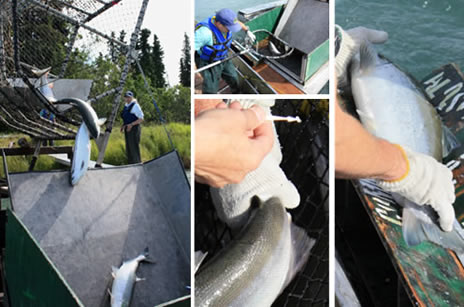
Kenai (RM 19) River
Other Tools
Other Tools

Estimating the abundance of a particular species of salmon in a river is easiest when they are not mixed with other fish species. Since sonar cannot identify fish by species, almost all Alaska Department of Fish and Game sonar sites use either gillnets or fish wheels to separate sonar-detected fish by species. At the Kenai River Mile 19 sonar site, ADF&G uses a fish wheel along the north bank. A fish wheel captures fish by scooping them out of the river with large baskets and depositing them into a live box. The relative proportion of sockeye salmon to other species caught in the fish wheel is then examined to determine how many of the sonar-detected fish should be counted as sockeye salmon.
Most of the time, more than 95 percent of the fish migrating into the Kenai River are sockeye salmon and the sonar-detected fish can all be counted as sockeye without separating them by species. The sonar site only separates sonar-detected fish by species when large numbers of pink salmon arrive, which is in early or mid August on even-numbered years. The fish wheel also catches a small number of coho salmon. The sonar site quits operating before pink and coho salmon runs are complete and does not produce estimates for these two species. The fish wheel captures fish near shore, where smaller salmon like sockeye, pink and some coho salmon migrate.
Even when the sonar site does not need fish wheel catches to separate sonar-detected fish by species, ADF&G runs the fish wheel every day to collect data from sockeye salmon. ADF&G technicians collect sex and length data, and scale samples from the fish. ADF&G biologists use the scale samples to determine the age of the fish and use this and the length and sex data to identify trends in returning sockeye runs from year to year.
